Orientation-Dependent Deformation Behavior of 316L Steel Manufactured by Laser Metal Deposition and Casting under Local Scratch and Indentation Load
Abstract
1. Introduction
2. Materials and Methods
2.1. Material and Processing
2.2. Nanoindentation
2.3. Scratch Testing
2.4. Atomic Force Microscopy and Confocal Laser Scanning Microscopy
2.5. Scanning Electron Microscopy
3. Results and Discussion
3.1. Microstructure
3.2. Scratching and Indentation
4. Summary and Conclusions
- Local deformation behavior during scratching is highly influenced by the crystallographic orientation. Within individual grains, the scratch depth and pile-up behavior are relatively homogeneous, whereas localization of plastic deformation occurs at grain boundaries with high pile-ups.
- Scratching of individual grains with scratches smaller than the grain size, reveals that the scratch resistance is a function of grain orientation, and generally increases in the order (001)-(101)-(111). This tendency is independent of the investigated processing routes (conventional casting and LMD). The influence of the crystallographic orientation is also seen in the hardness measured by nanoindentation and correlates with the scratch depth.
- LMD processing leads to a reduction in scratch depth in comparison to casting. However, the deformation behavior in terms of pile-up height and the fab parameter are not significantly altered. Hence, LMD-processed microstructures show a higher local scratch resistance compared to the microstructures produced by conventional casting.
- The higher strength, hardness, and scratch resistance of LMD-processed microstructures is most likely due to a higher dislocation density. Pop-in phenomenon in the early beginning of the loading curve indicate a low defect density, and hence low dislocation density after the conventional casting route. The higher dislocation density and number of dislocation sources of the LMD-processed microstructure leads to early and continuous dislocation nucleation, and thus pop-ins are suppressed.
- A direct effect of the cellular substructure on the local deformation behavior during scratch and indentation testing is not seen. Pile-up behavior and occurring slip lines are not noticeably affected by the substructure.
- The indentation size effect (ISE) was investigated in nearly (001)-oriented grains. In the investigated grains, the ISE appeared to be of the same magnitude, independent of the processing route.
Author Contributions
Funding
Acknowledgments
Conflicts of Interest
References
- Thompson, S.M.; Bian, L.; Shamsaei, N.; Yadollahi, A. An overview of direct laser deposition for additive manufacturing; Part 1: Transport phenomena, modeling and diagnostics. Addit. Manuf. 2015, 36–62. [Google Scholar] [CrossRef]
- Selcuk, C. Chapter 13: Joining processes for powder metallurgy parts. In Advances in Powder Metallurgy; Woodhead Publishing Series in Metals and Surface Engineering: Duxford, UK, 2013; pp. 380–398. [Google Scholar]
- Najmon, C.J.; Raeisi, S.; Tovar, A. Chapter 2: Review of additive manufacturing technologies and applications in the aerospace industry. In Additive Manufacturing for the Aerospace Industry; Froes, F., Boyer, R., Eds.; Elsevier: Amsterdam, The Netherlands, 2019; pp. 7–31. [Google Scholar]
- van Noort, R. The future of dental devices is digital. Dent. Mater. 2012, 28, 3–12. [Google Scholar] [CrossRef] [PubMed]
- Traxel, D.; Bandyopadhyay, A. First demonstration of additive manufacturing of cutting tools using direct energy deposition system: Stellite(TM)-based cutting tools. Addit. Manuf. 2019, 25, 460–468. [Google Scholar]
- Gu, D.-D.; Meiners, W.; Wissenbach, K.; Poprawe, R. Laser additive manufacturing of metallic components: Materials, processes and mechanisms. Int. Mater. Rev. 2013, 57, 133–164. [Google Scholar] [CrossRef]
- Wang, Y.-M.; Voisin, T.; McKeown, J.-T.; Ye, J.; Calta, N.-P.; Li, Z.; Zeng, Z.; Zhang, Y.; Chen, W.; Roehling, T.-T.; et al. Additively manufactured hierarchical stainless steels with high strength and ductility. Nat. Mater. 2018, 17, 63–71. [Google Scholar] [CrossRef]
- Sun, Z.; Tan, X.; Tor, S.B.; Yeong, W.Y. Selective laser melting of stainless steel 316L with low porosity and high build rates. Mater. Des. 2016, 104, 197–204. [Google Scholar] [CrossRef]
- Afkhami, S.; Dabiri, M.; Alavi, S.-H.; Björk, T.; Salminen, A. Fatigue characteristics of steels manufactured by selective laser melting. Int. J. Fatigue 2019, 122, 72–83. [Google Scholar] [CrossRef]
- Solberg, K.; Guan, S.; Razavi, S.-M.; Welo, T.; Chan, K.-C.; Berto, F. Fatigue of additively manufactured 316L stainless steel: The influence of porosity and surface roughness. Fatigue Fract. Eng. Mater. Struct. 2019, 42, 2043–2052. [Google Scholar] [CrossRef]
- Guo, P.; Zou, B.; Huang, C.; Gao, H. Study on microstructure, mechanical properties and machinability of efficiently additive manufactured AISI 316L stainless steel by high-Power direct laser deposition. J. Mater. Process. Technol. 2017, 240, 12–22. [Google Scholar] [CrossRef]
- Shamsaei, N.; Yadollahi, A.; Bian, L.; Thompson, S.-M. An overview of Direct Laser Deposition for additive manufacturing; Part II: Mechanical behavior, process parameter optimization and control. Addit. Manuf. 2015, 8, 12–35. [Google Scholar] [CrossRef]
- Gray, G.-T.; Livescu, V.; Rigg, P.-A.; Trujillo, C.-P.; Cady, C.-M.; Chen, S.-R.; Carpenter, J.-S.; Lienert, T.-J.; Fensin, S.-J. Structure/property (constitutive and spallation response) of additively manufactured 316L stainless steel. Acta Mater. 2017, 138, 140–149. [Google Scholar] [CrossRef]
- Lou, X.; Andresen, P.-L.; Rebak, R.-B. Oxide inclusions in laser additive manufactured stainless steel and their effects on impact toughness and stress corrosion cracking behavior. J. Nucl. Mater. 2018, 499, 182–190. [Google Scholar] [CrossRef]
- Hardes, C.; Pöhl, F.; Röttger, A.; Thiele, M.; Theisen, W.; Esen, C. Cavitation erosion resistance of 316L austenitic steel processed by selective laser melting (SLM). Addit. Manuf. 2019. [Google Scholar] [CrossRef]
- Sun, Y.; Moroz, A.; Alrbaey, K. Sliding Wear Characteristics and Corrosion Behaviour of Selective Laser Melted 316L Stainless Steel. J. Mater. Eng. Perform. 2013, 23, 518–526. [Google Scholar] [CrossRef]
- Bartolomeu, F.; Buciumeanu, M.; Pinto, E.; Alves, N.; Carvalho, O.; Silva, F.-S.; Mirande, G. 316L stainless steel mechanical and tribological behavior—A comparison between selective laser melting, hot pressing and conventional casting. Addit. Manuf. 2017, 16, 81–89. [Google Scholar] [CrossRef]
- Li, H.; Ramezani, M.; Li, M.; Ma, C.; Wang, J. Tribological performance of selective laser melted 316L stainless steel. Tribol. Int. 2018, 128, 121–129. [Google Scholar] [CrossRef]
- Chen, T.; Tan, L.; Lu, Z.; Xu, H. The effect of grain orientation on nanoindentation behavior of model austenitic alloy Fe-20Cr-25Ni. Acta Mater. 2017, 138, 83–91. [Google Scholar] [CrossRef]
- Nibur, K.-A.; Bahr, D.-F. Identifying slip systems around indentations in FCC metals. Scr. Mater. 2003, 49, 1055–1060. [Google Scholar] [CrossRef]
- Wang, Y.; Raabe, D.; Klüber, C.; Roters, F. Orientation dependence of nanoindentation pile-Up patterns and of nanoindentation microtextures in copper single crystals. Acta Mater. 2004, 52, 2229–2238. [Google Scholar] [CrossRef]
- Ye, D.; Matsuoka, S.; Nagashima, N. Determination of fatigue mesoscopic mechanical porperties of an austenitic stainless steel using depth-sensing indentation (DSI) technique. Mater. Sci. Eng. A 2007, 456, 120–129. [Google Scholar] [CrossRef]
- Hallensleben, P.; Scharr, H.; Thome, P.; Jöns, N.; Jafarizadeh, A.; Steinbach, I.; Eggeler, G.; Frenzel, J. "On the evolution of cast microstructures during processing of single crystal Ni-base superalloys using a Bridgman seed technique. Mater. Des. 2017, 98–111. [Google Scholar] [CrossRef]
- Oliver, W.-C.; Pharr, G.-M. An improved technique for determining hardness and elastic modulus using load and displacement sensing indentation experiments. J. Mater. Res. 1992, 7, 1564–1583. [Google Scholar] [CrossRef]
- Oliver, W.-C.; Pharr, G.-M. Measurement of hardness and elastic modulus by instrumented indentation: Advances in understanding and refinements to methodology. J. Mater. Res. 2003, 19, 3–20. [Google Scholar] [CrossRef]
- Cheng, Y.-T.; Cheng, C.-M. Scaling, Dimensional Analysis, and Indentation Measurements. Mater. Sci. Eng. R Rep. 2004, 44, 91–149. [Google Scholar] [CrossRef]
- Pöhl, F.; Huth, S.; Theisen, W. Indentation of self-similar indenters: An FEM-Assisted energy-Based analysis. J. Mech. Phys. Solids 2014, 66, 32–41. [Google Scholar] [CrossRef]
- Li, X.; Bhushan, B. A review of nanoindentation continuous stiffness measurement technique and its applications. Mater. Charact. 2002, 48, 11–36. [Google Scholar] [CrossRef]
- Zum Gahr, K.-H. Microstructure and Wear of Materials; Tribology Series 10; Elsevier: Amsterdam, The Netherlands, 1987. [Google Scholar]
- Thome, P.; Medghalchi, S.; Frenzel, J.; Schreuer, J.; Eggeler, G. Ni-base superalloy single crystal (SX) mosaicity characterized by the Rotation Vector Base Line Electron Back Scatter Diffraction (RVB-EBSD) method. Ultramicroscopy 2019, 206, 112817. [Google Scholar] [CrossRef]
- Sekido, K.; Ohmura, T.; Hara, T.; Tsuzaki, K. Effect of Dislocation Density on the Initiation of Plastic Deformation on Fe-C Steels. Mater. Trans. 2012, 55, 907–9012. [Google Scholar] [CrossRef]
- Nix, W.-D.; Gao, H. Indentation size effect in crystalline materials: A law for strain gradient plasticity. J. Mech. Phys. Solids 1998, 46, 411–425. [Google Scholar] [CrossRef]
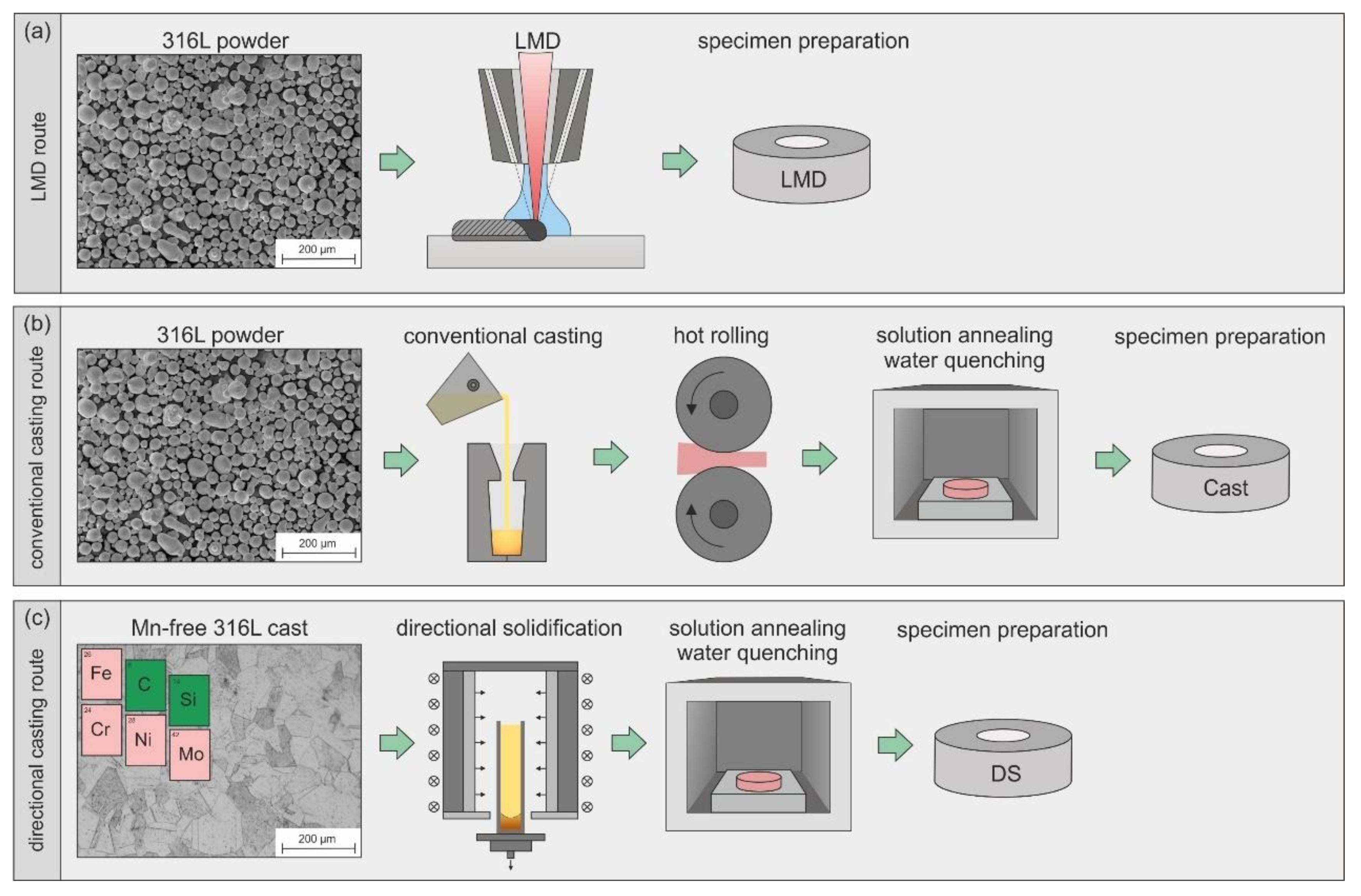
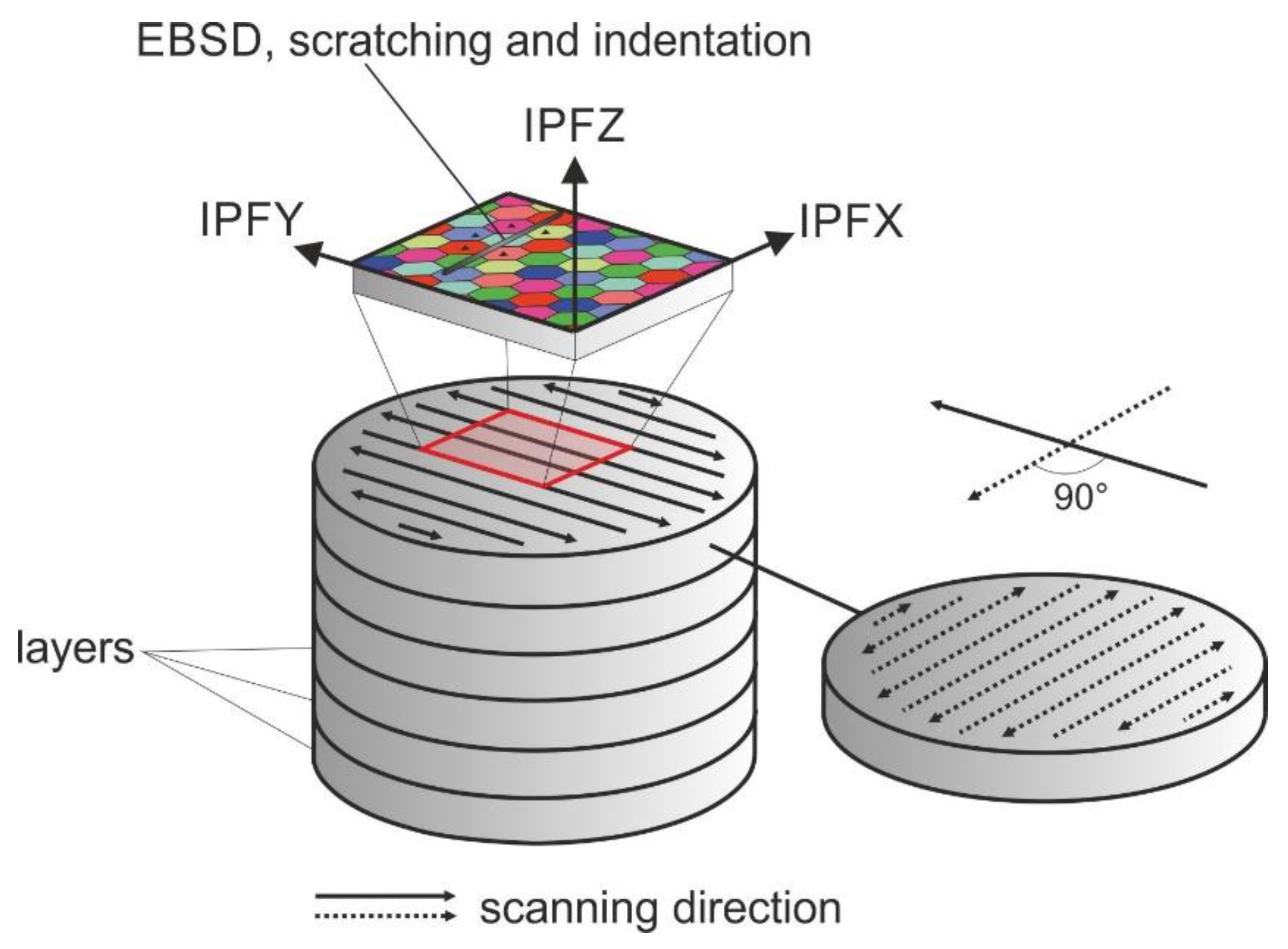
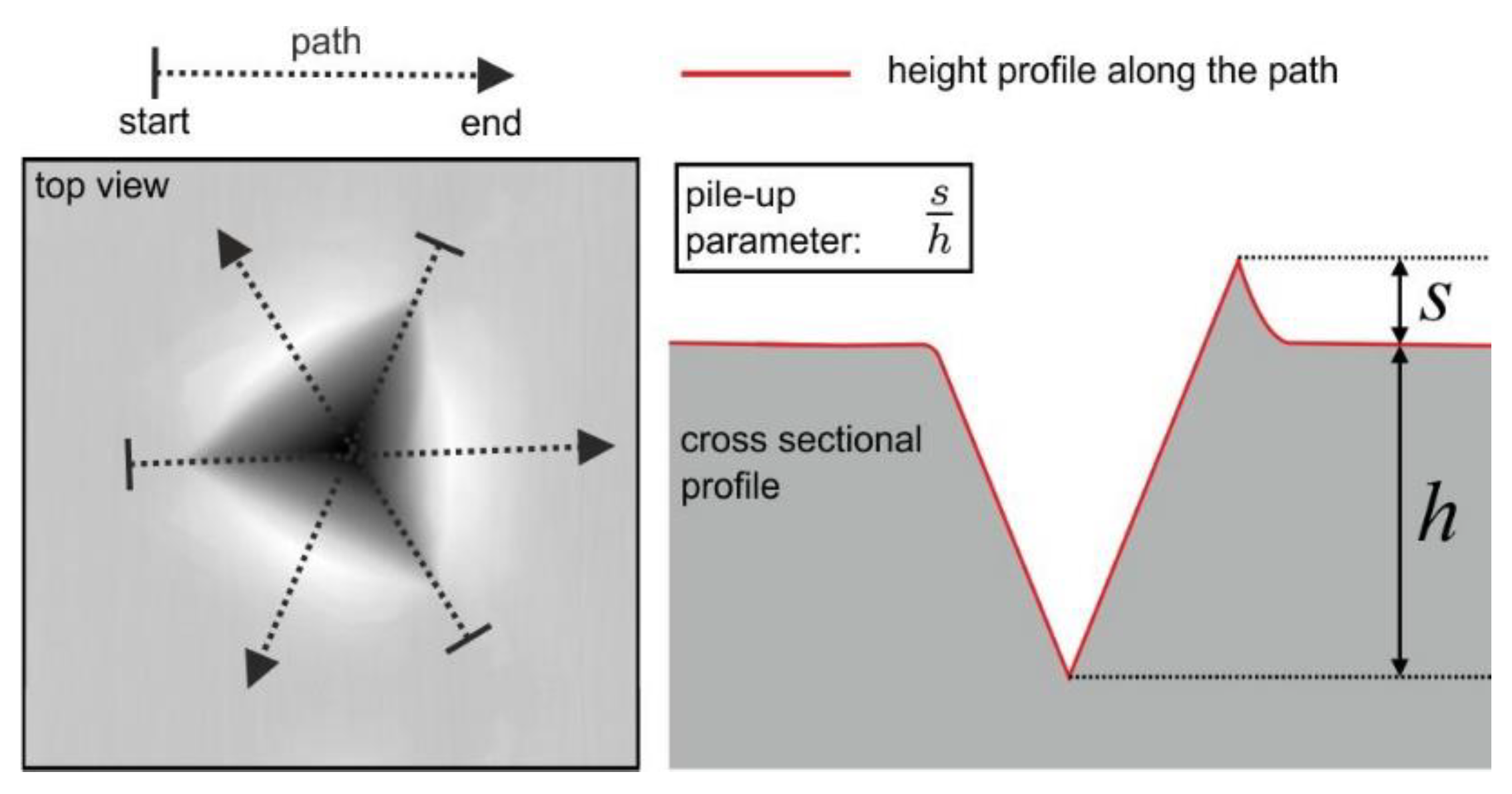
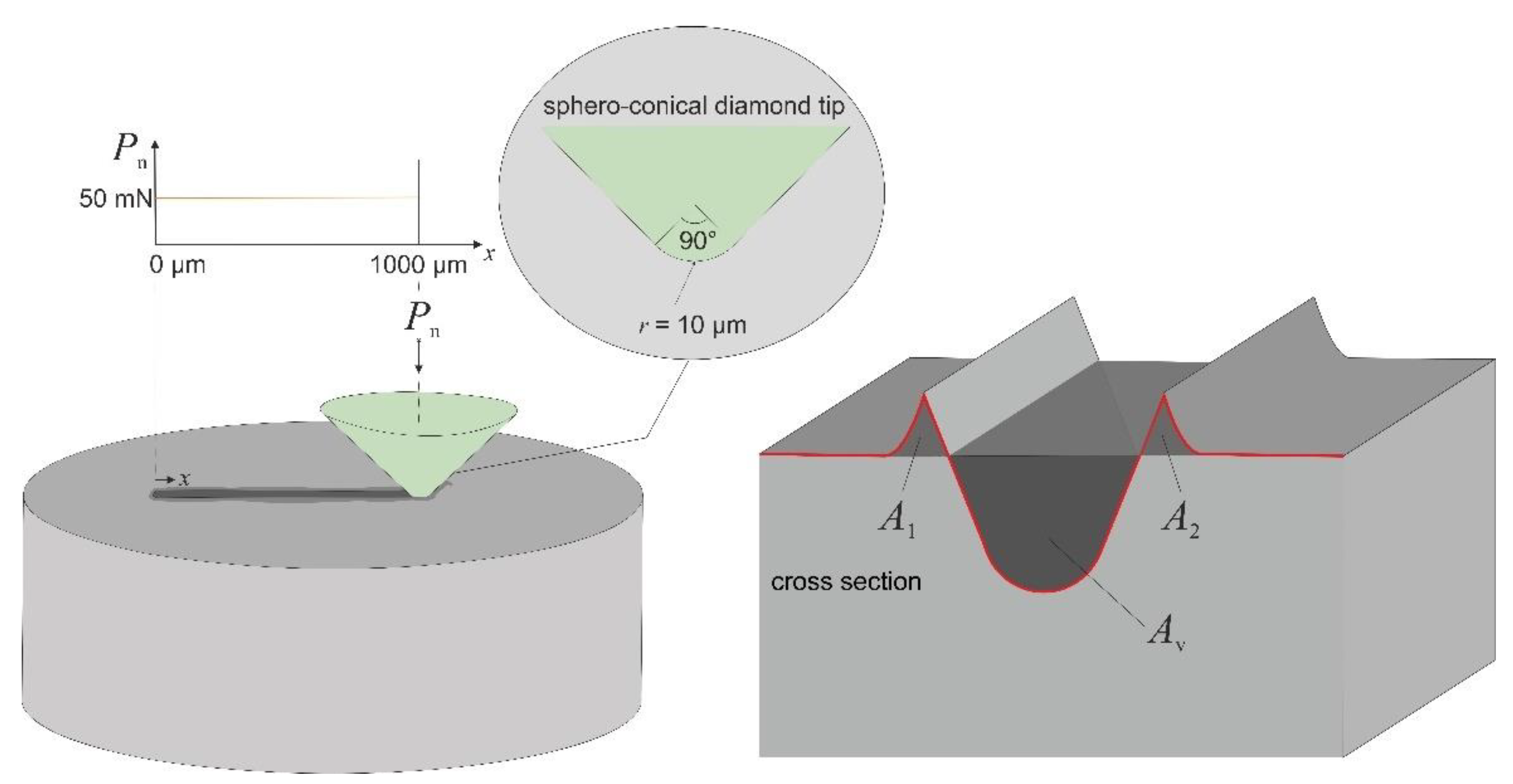





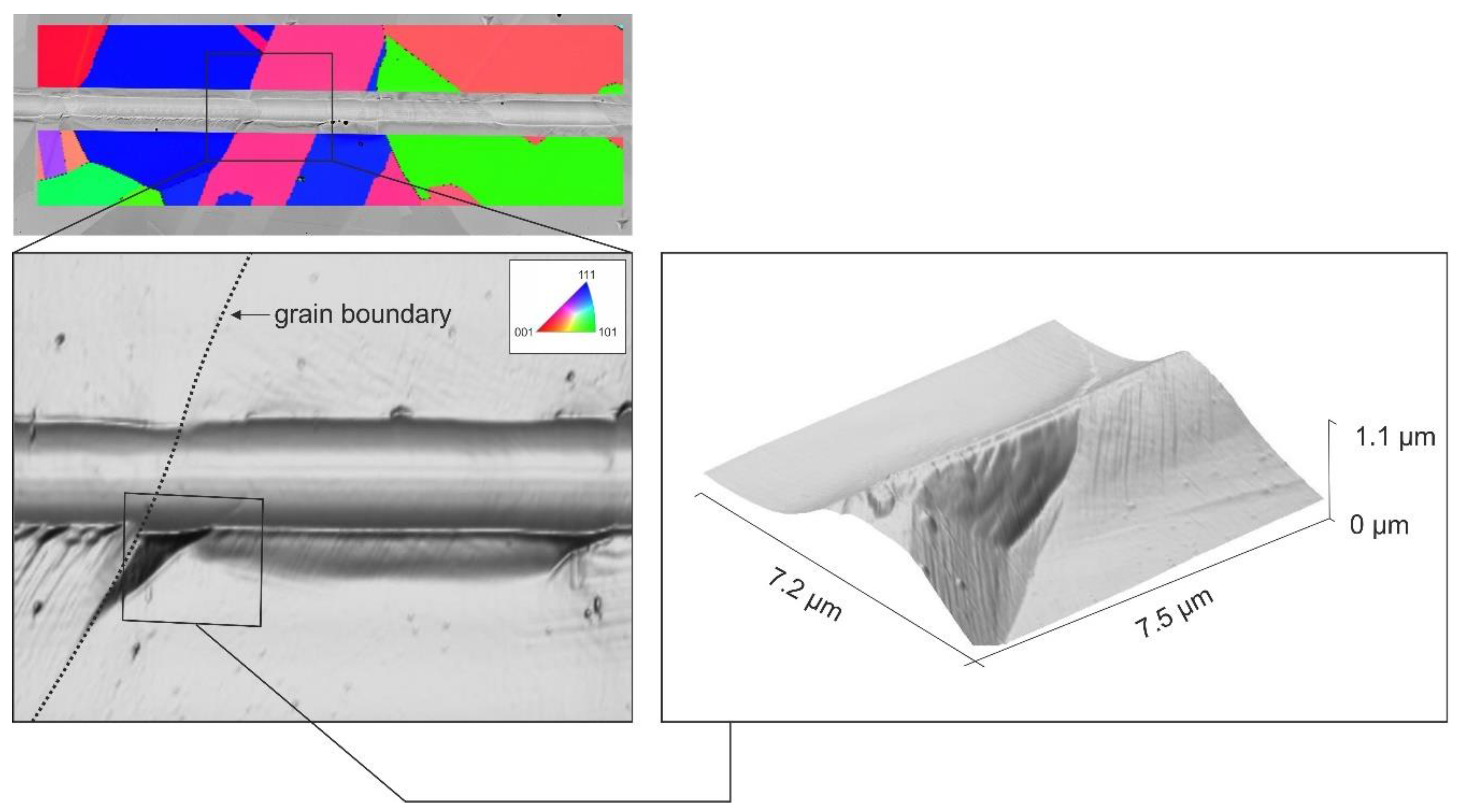
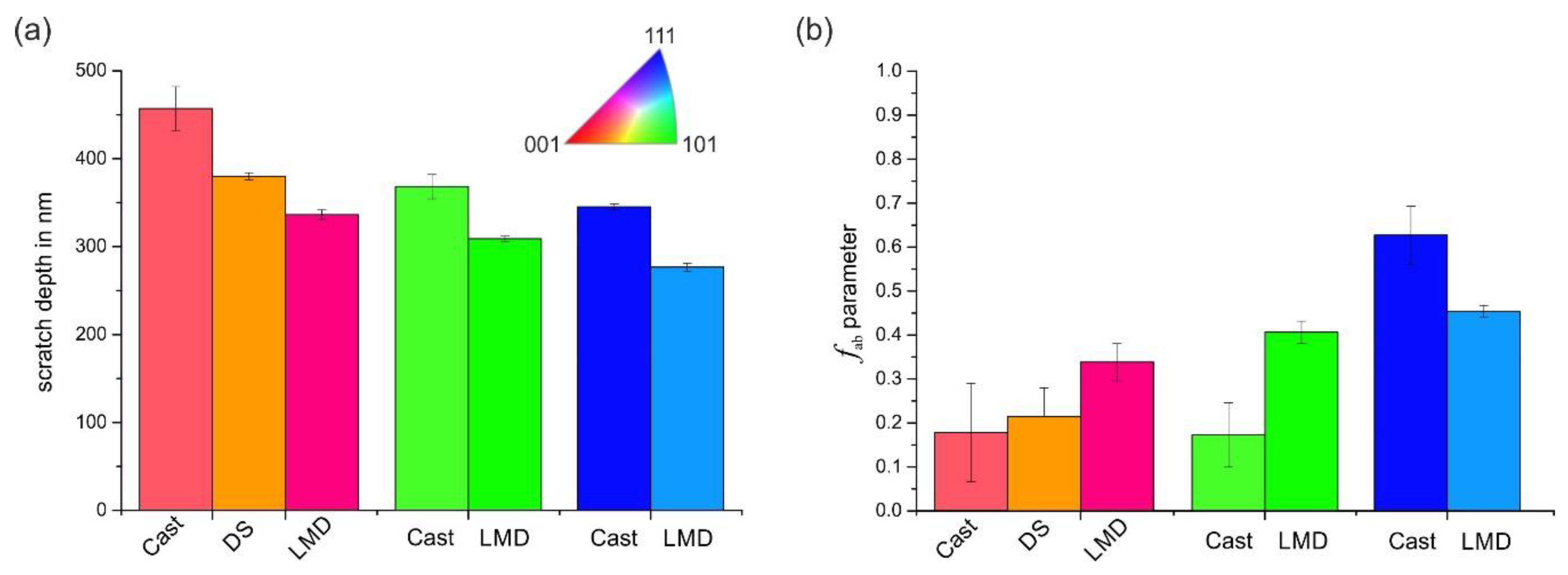
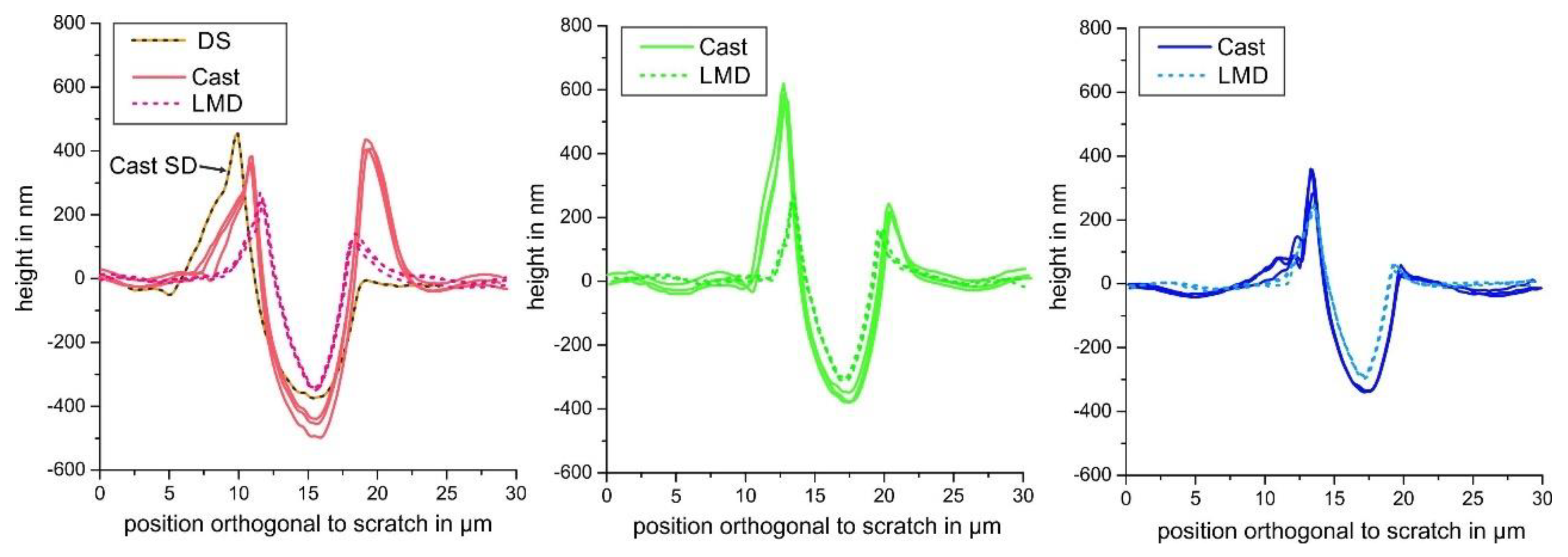
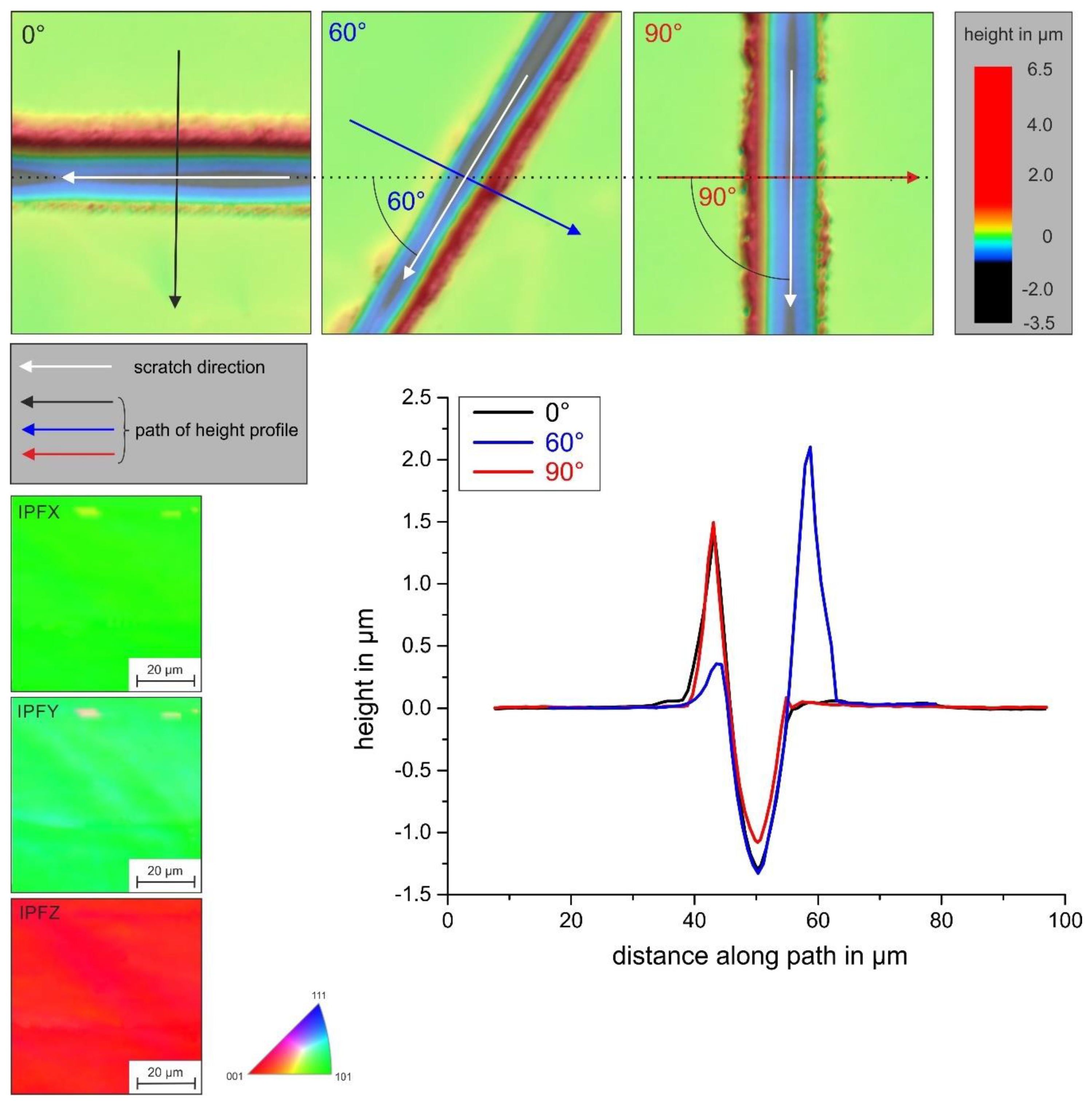
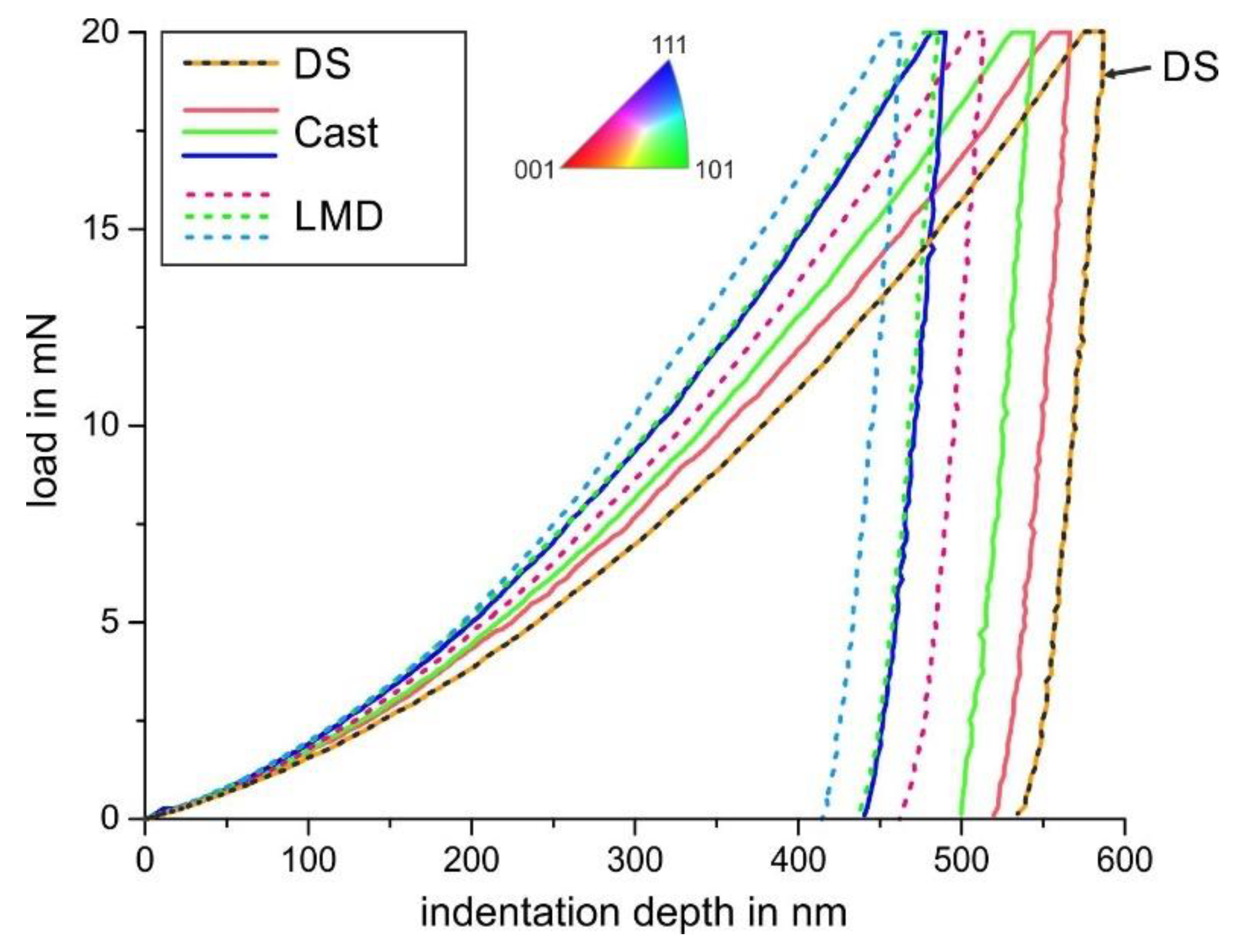



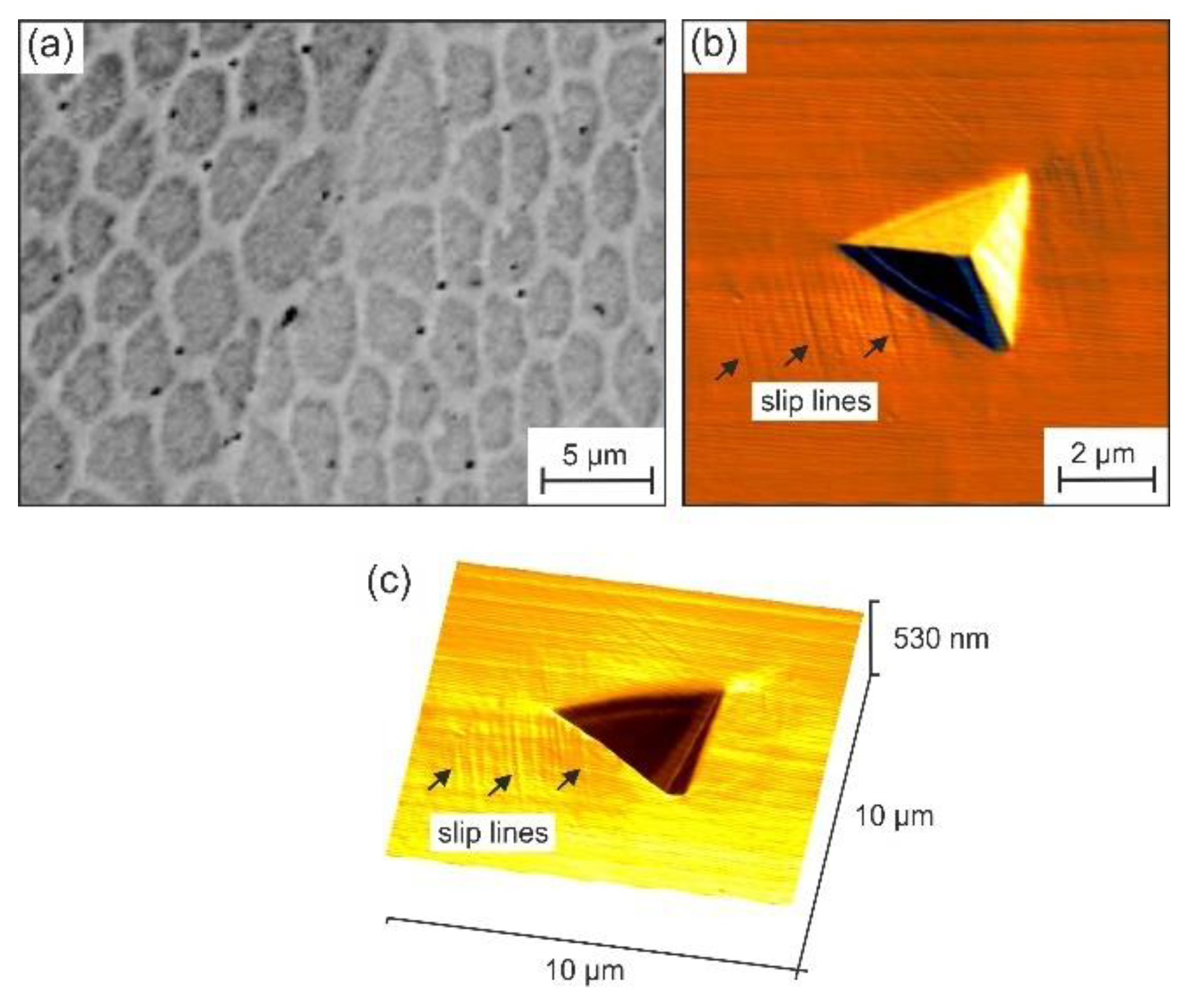
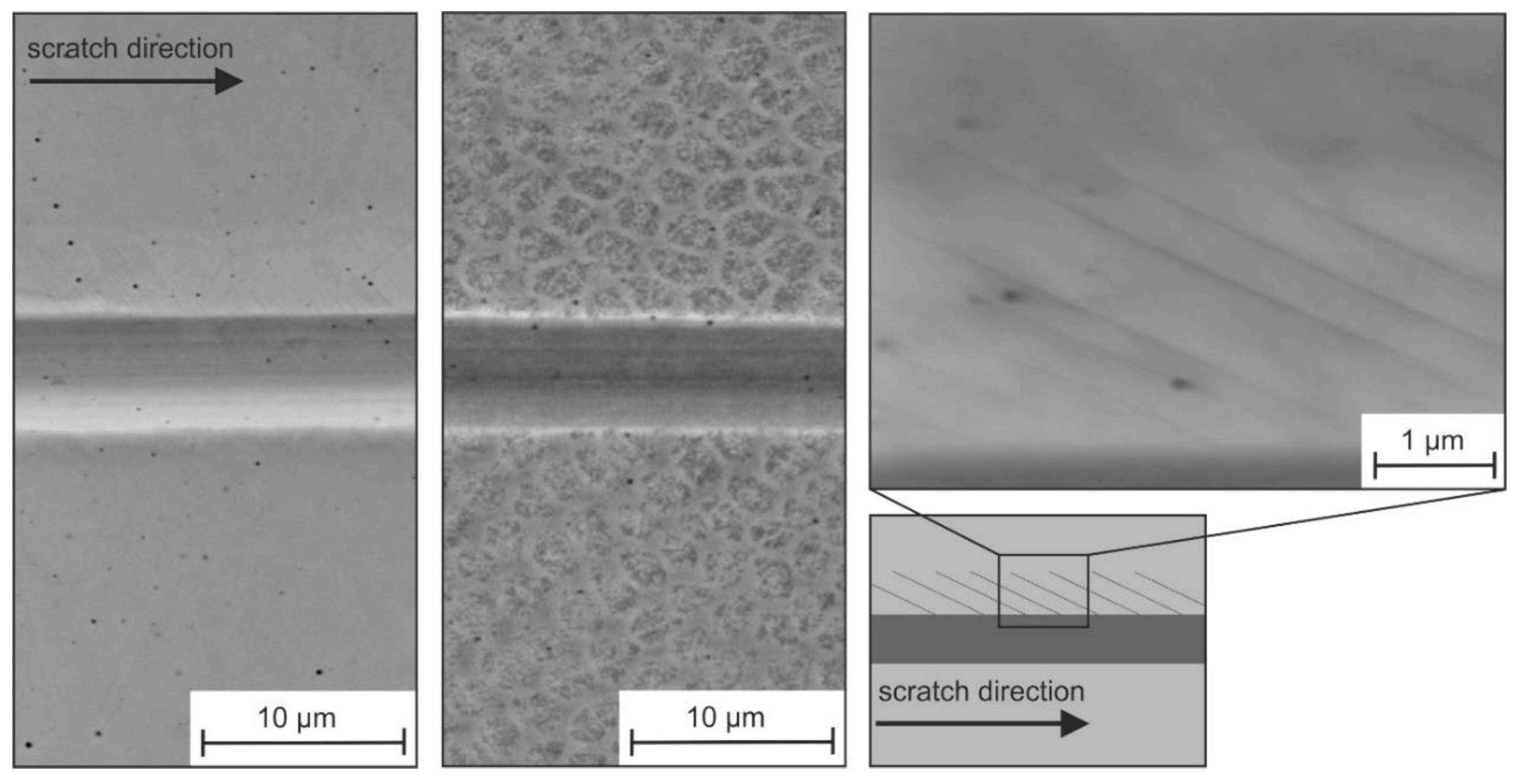
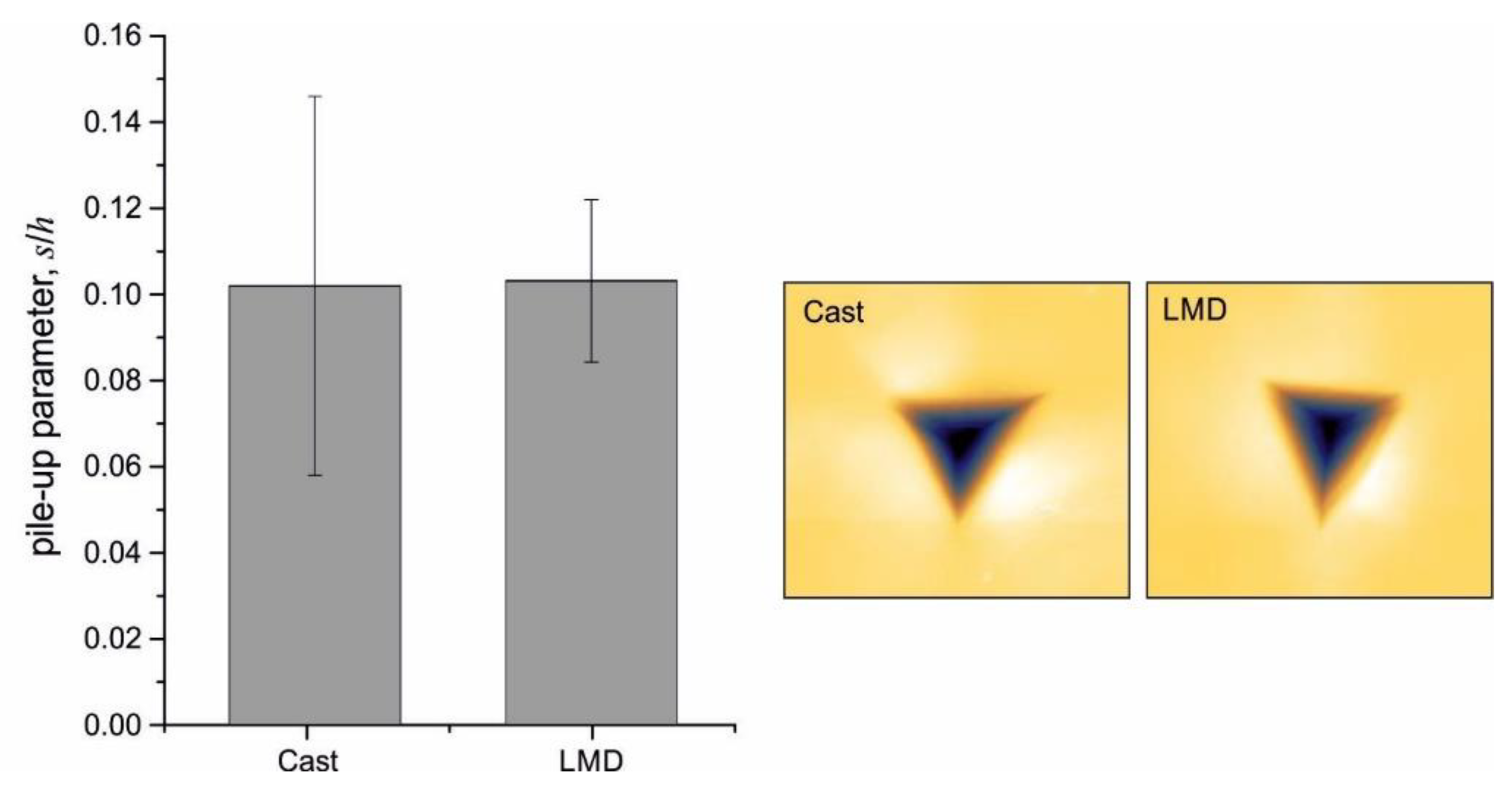

| Laser Power | Focus Diameter | Feed Rate | Powder Feed Rate | Hatch Distance | Layer Height |
|---|---|---|---|---|---|
| 315 W | 1 mm | 10 mm/s | 2.3 g/min | 0.5 mm | 0.3 mm |
| Processing Route | C | N | Mn | Si | Cr | Ni | Mo | S + P | Fe |
|---|---|---|---|---|---|---|---|---|---|
| Cast | 0.07 | 0.04 | 0.73 | 0.82 | 16.67 | 12.71 | 2.47 | 0.02 | bal. |
| LMD | |||||||||
| DS | 0.03 | 0.04 | 0.08 | 0.02 | 17.65 | 11.08 | 2.43 | 0.01 | bal. |
© 2020 by the authors. Licensee MDPI, Basel, Switzerland. This article is an open access article distributed under the terms and conditions of the Creative Commons Attribution (CC BY) license (http://creativecommons.org/licenses/by/4.0/).
Share and Cite
Pöhl, F.; Hardes, C.; Scholz, F.; Frenzel, J. Orientation-Dependent Deformation Behavior of 316L Steel Manufactured by Laser Metal Deposition and Casting under Local Scratch and Indentation Load. Materials 2020, 13, 1765. https://doi.org/10.3390/ma13071765
Pöhl F, Hardes C, Scholz F, Frenzel J. Orientation-Dependent Deformation Behavior of 316L Steel Manufactured by Laser Metal Deposition and Casting under Local Scratch and Indentation Load. Materials. 2020; 13(7):1765. https://doi.org/10.3390/ma13071765
Chicago/Turabian StylePöhl, Fabian, Corinna Hardes, Felicitas Scholz, and Jan Frenzel. 2020. "Orientation-Dependent Deformation Behavior of 316L Steel Manufactured by Laser Metal Deposition and Casting under Local Scratch and Indentation Load" Materials 13, no. 7: 1765. https://doi.org/10.3390/ma13071765
APA StylePöhl, F., Hardes, C., Scholz, F., & Frenzel, J. (2020). Orientation-Dependent Deformation Behavior of 316L Steel Manufactured by Laser Metal Deposition and Casting under Local Scratch and Indentation Load. Materials, 13(7), 1765. https://doi.org/10.3390/ma13071765






